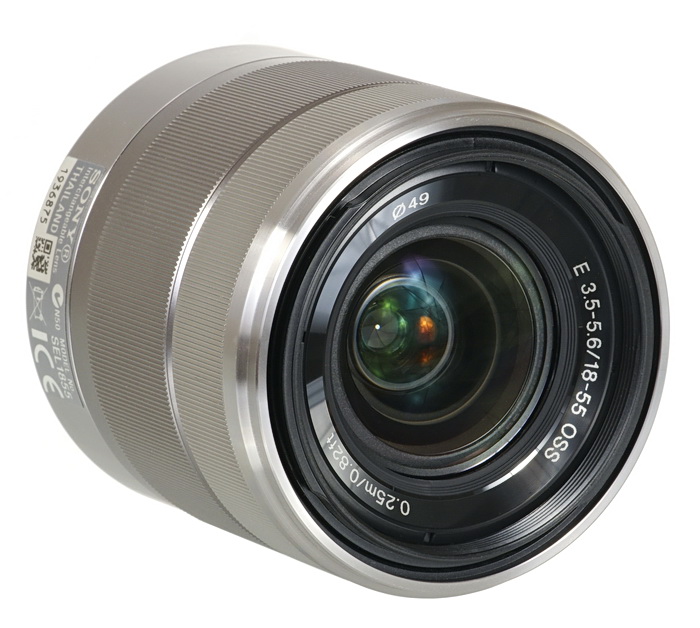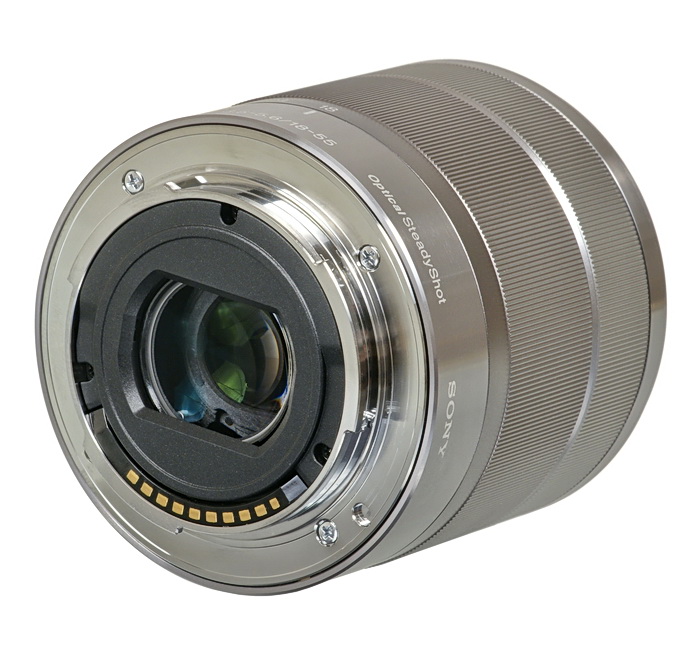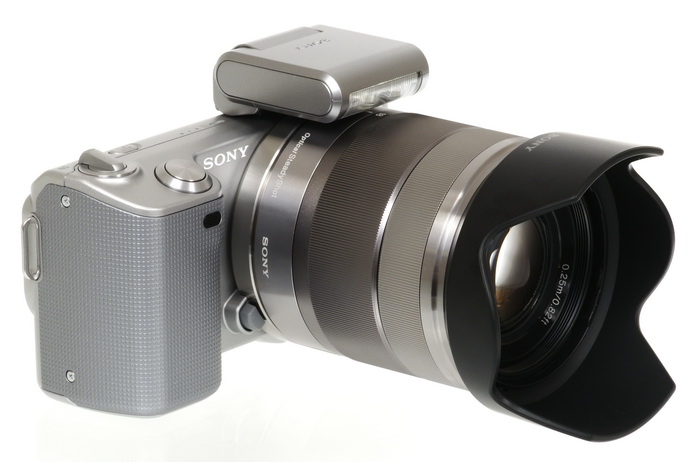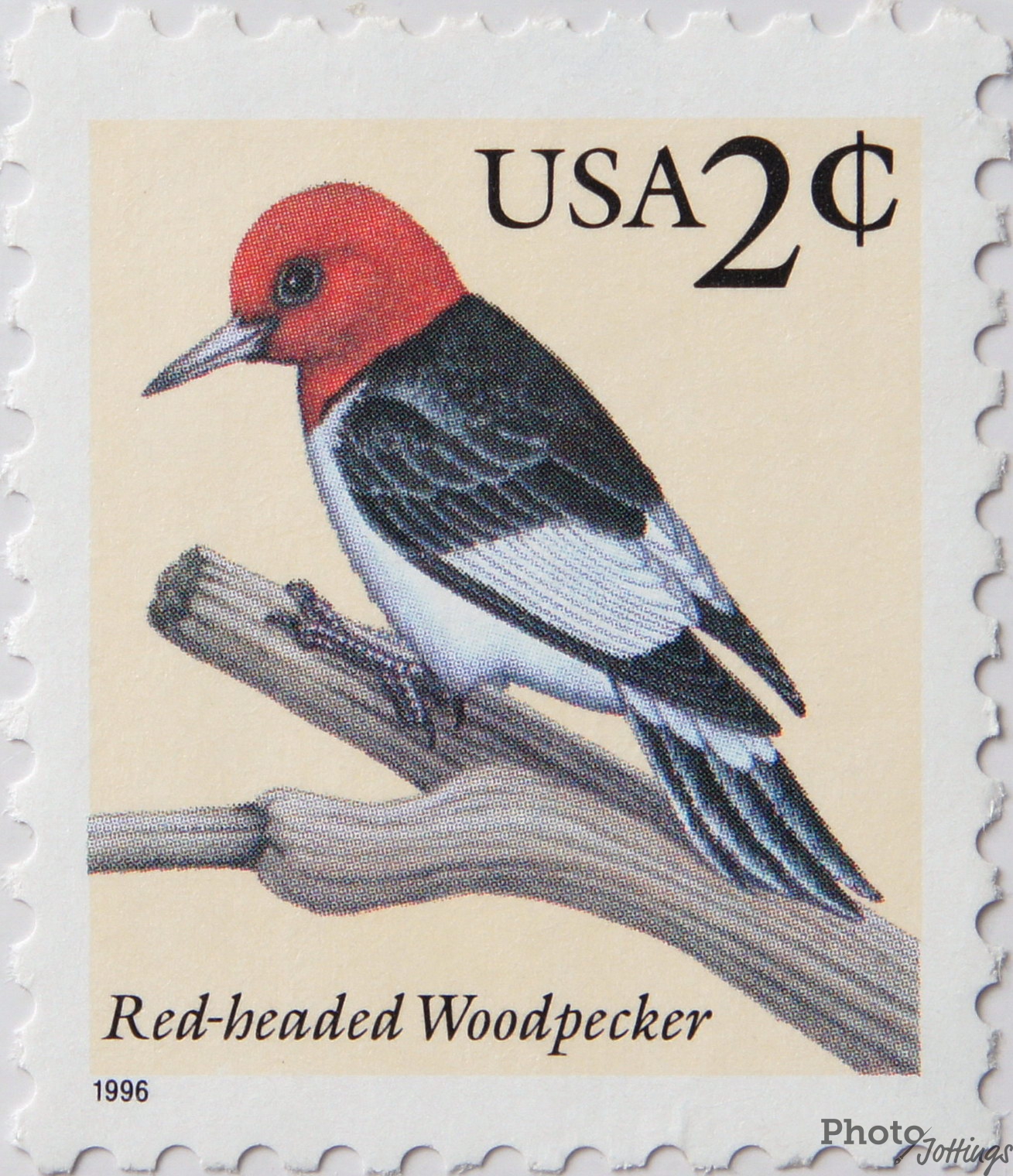|
Lens
|
|
|
Box contents
|
Hood, front and rear caps and a user’s manual.
|
|
Cost
|
$300, or an extra $100 with camera as a kit.
|
|
Build quality
|
Very good.
|
|
Additional information
|
Introduced in 2010. Has built-in optical image stabilization or OSS, and a focus motor inside similar to SSM, not the cheaper SAM.
|
| Specifications below |
|
|
Optical configuration
|
11 elements in 9 groups
|
|
Angle of view
|
76°-29° APS-C
|
|
Aperture
|
7 blades, almost straight
|
|
Full frame and APS-C
|
APS-C only, and will only mount on E body cameras. With crop factor of 1.5x the coverage equals 27-82.5mm.
|
|
Depth of field and focus scales?
|
Nothing.
|
|
Min. focus distance, image plane to subject @ max reproduction ratio
|
9.8″ (0.25m)
|
|
Min. focus distance, end of lens barrel to subject @ max reproduction ratio
|
5.5″ (140mm)
|
|
Hard stop at infinity focus?
|
No
|
|
Length changes when focusing?
|
No
|
|
Focus ring turns in AF?
|
No
|
|
Filter size
|
49mm
|
|
Filter ring rotates?
|
No
|
|
Distance encoder?
|
Yes
|
|
Max magnification
|
0.30x, or 1:3.33
|
|
Min. F/stop
|
F/22-32
|
|
Sony teleconverter compatible?
|
No
|
|
Length changes when zooming?
|
Yes
|
|
Dimensions WxL (my measurements)
|
2.45″ x 2.37″ 62mm x 60mm.
|
|
Maximum extended length (my measurements)
|
3.3″ (83.5mm)
|
|
Weight bare (my scale)
|
6.8oz (194g)
|
 |
| Front element |
 |
| Backside mount |
 |
| NEX 5 with 18-55mm lens and included hood |
 |
| Fully drawn in |
 |
| Fully extended |
 |
| X-ray view and MTF chart |
The new NEX cameras are currently offered with two lens choices (as of 9/10), a pancake 16mm, and our review lens, the NEX e-mount 18-55mm F/3.5-5.6. This zoom lens is very similar in optical performance to theSony DT 18-55mm SAM lens but outwardly is very different. There is no mistaking the build quality and materials used in the construction of this lens with the cheap plastic DT 18-55mm lens. The NEX 18-55mm F/3.5-5.6 (Made in Thailand) is build solidly, has a nice smooth zoom and manual focus action, along with a silent auto-focus motor which is great for keeping focus noise out of movies. You’ll also notice the OSS, or optical steady shot, built into the lens, a first for Sony. Sony and Minolta AF (a-mount) lenses have no image stabilization, instead, Sony uses in-camera body sensor-shift type image stabilization.
Fit and finish are very good. The lens appears to be clad in metal, although it does have a plastic extension tube and filter ring. It also has a metal mount and the ability to use 49mm filters. The color is silver, like stainless steel, but seems to turn color slightly with a different angle of light, see product shots above. Strange, but true; the specs say circular aperture, but I start to see heptagons less than one stop down in background highlight blur, which means it’s not a true circular aperture. that’s no big deal, I’m just pointing it out.
 |
| 18mm, strong barrel distortion |
 |
| 55mm, moderate pincushion distortion. |
Aperture/focal length guide.
|
Maximum aperture
|
F/3.5
|
F/4
|
F/4.5
|
F/5
|
F/5.6
|
|
Range
|
18mm-19mm
|
19mm – 30mm
|
30mm – 42mm
|
42mm – 51mm
|
52mm – 55mm
|
|
18mm F/3.5
|
18mm F/5.6
|
 |
 |
|
55mm F/5.6
|
55mm F/8
|
 |
 |
Bokeh is harsh at 18mm, producing a noticeable ring around highlights, that’s typical for kit lenses. Towards the long end, the out of focus background highlights are rendered a little smoother. Crops are from the center of the image, about 10′ to 20′ (3m-6m) behind the focus point.
|
18mm F/3.5
|
18mm F/5.6
|
 |
 |
Coma is only barely visible in this 100% corner crop at 18mm, and then only when using the largest aperture.
|
18mm F/5.6
|
36mm F/5.6
|
 |
 |
|
55mm F/5.6
|
18mm F/5.6
|
 |
 |
Ghosting control is very good, and these images show very little in the way of colored dots or blurred circles. I see just a few spots (middle of palm trees) in the 18mm, F/5.6 vertical image, bottom right, and a minor smudge at 36mm, F/5.6, (no hood was used), top right, which is just off to the left of the image. Using my hand to shade the lens would’ve eliminated that smudge.
|
18mm F/3.5
|
18mm F/5.6
|
 |
 |
|
55mm F/5.6
|
55mm F/8
|
 |
 |
|
F/3.5
|
F/5.6
|
 |
 |
|
F/8
|
F/11
|
 |
 |
|
F/3.5
|
F/5.6
|
 |
 |
|
F/8
|
F/11
|
 |
 |
At the mid-section, sharpness is best at F/5.6-8, and there is a noticeable change in sharpness as you stop down. Diffraction sets in at F/11.
Below are the corners at 18mm.
|
F/3.5
|
F/5.6
|
 |
 |
|
F/8
|
F/11
|
 |
 |
 |
| 18mm, F/8 extreme left side at middle of image |
|
F/5.6
|
F/8
|
 |
 |
|
F/11
|
F/16
|
 |
 |
|
F/5.6
|
F/8
|
 |
 |
|
F/11
|
F/16
|
 |
 |
At the mid-section, things look very similar to the center crops.
Below are the corners at 55mm.
|
F/5.6
|
F/8
|
 |
 |
|
F/11
|
F/16
|
 |
 |
Now for the conclusion.
This kit zoom lens turned in a pretty good performance overall, and works best at F/5.6-8, which is good news too. The long end has some good qualities, like smooth bokeh or background highlight blur, lack of color fringing, and very good overall sharpness, although a little soft at F/5.6 in the extreme corners. The wide end is very sharp in the centers and mid-section, but the extreme corners need to be stopped down; and of course don’t forget the strong color fringing and distortion that occurs at and near 18mm. There is a slight lack of contrast with the lens towards the long end, (noticeable in the macro shot), but that’s normal for an inexpensive kit type lens, you can’t have everything. None of these things are a big deal unless you stare at your images all day blown way up on your computer screen, or have a high megapixel camera like the NEX-7.
This lens is similar in optical performance to the Sony 18-55mm A-mount lens, but there are some noticeable differences other than optical qualities, like the fact that this NEX e-mount lens is built much better, and is smoother when zooming and manually focusing. Also, the NEX 18-55mm silent, and pretty fast focusing motor is light years ahead of Sony’s poorly implemented SAM focusing system, just be aware of the focusing issue as mentioned at the top. Bottom line; check your shots using the LCD!
The NEX e-mount 18-55mm makes a good lens to keep permanently on your NEX camera (unless you have the NEX-7), it’s not so big and heavy to become burdensome, and just small and light enough to be pocket-able, well, maybe not your jeans pocket, but a jacket pocket definitely!
